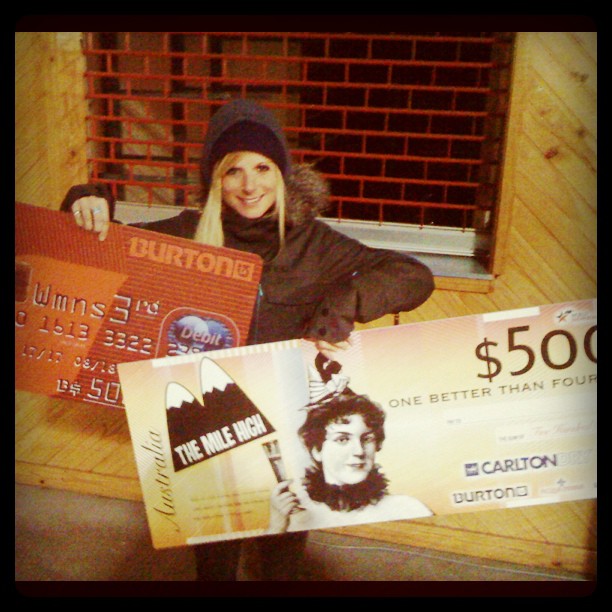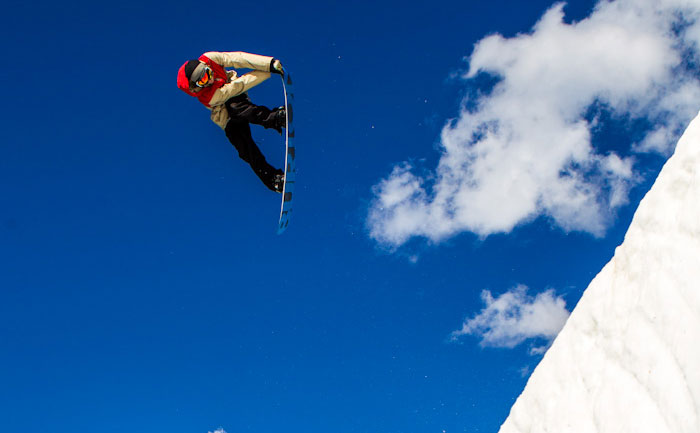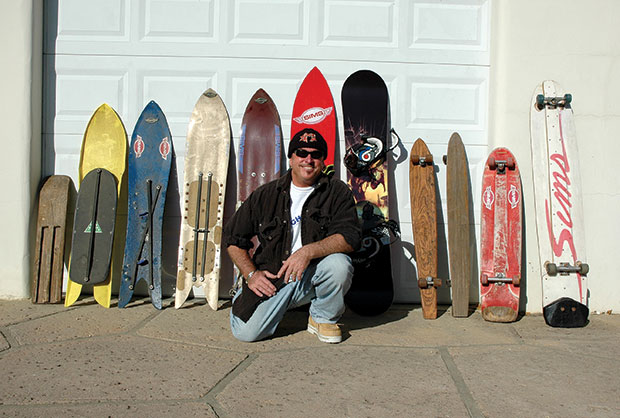Following the sad news of his death, we thought we’d re-publish this interview with the late, great Mr Sims from 2010.
Published in Whitelines Magazine Issue 88, January 2010
Words: Matt Barr
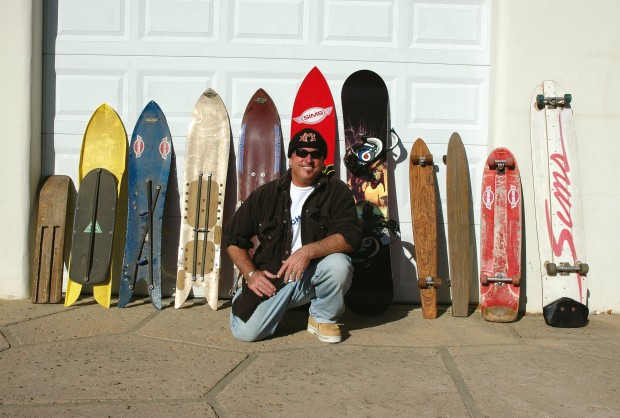
On the phone from California, Tom Sims is mulling over an important question for all snowboarders. Just what is his greatest achievement in this, the longest of all riding careers? “Building the first snowboard in 1963,” he eventually answers. “Prior to what I had, there were only a couple of standup toboggans with handles. I’m also proud of building the first half pipe in 1983. And then designing the original Sims highback in 1985. That was my third big invention.”
We’ll probably never be able to carbon date the exact date that snowboarding ‘began’. Most traditional accounts start with Sherman Poppen’s invention of the Snurfer in 1965. But Tom Sims probably has a better claim than anybody else to be the original shredder, the first visionary to marry the sports of skiing and surfing. He even has the dates to prove it. ”When did I first try it? Haddon Field, New Jersey in December 1963. I was in woodshop class in fall 1963 and we made a two-foot long sailboat, glued together with pieces of pinewood and shaped with a hand plane. The scoop on the front of the boat is what have me the idea for the front of the snowboard. I was 13.”
And so, a year before Tom Burt’s birth and 11 before Terje Hakonsen’s, Tom went ‘ski-boarding’ for the very first time. For the first few years, it was just Tom and his two friends Don and Greg, “who were the only two guys even interested. The jocks just chuckled at me coming down the sledding hill on my ski-board at this time”. It took the arrival of the Snurfer – essentially, a stand-up sled with a rope for balance – for this ski-boarding/snowboarding concept to take off and for the world to catch up with this skateboard crazy New Jersey kid. For Tom, the Snurfer ‘fad’ hit a peak in 1969, which is when he refined his own ideas and “a lot of people got involved” (including Jake Burton, with future ramifications for Sims and the sport at large, as we will see).
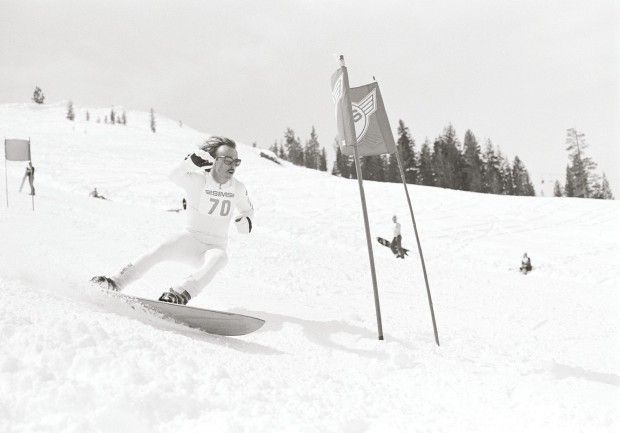
“Technology-wise, my boards didn’t improve until 1968, 1969 when I was building surfboards in our garage. I made a full size snowboard. It was 150 cm, with no side cut and had no bindings. So I put silicon dots on it for traction. I never put too many miles on that board else I would have put bindings on it. Just never did. Then it disappeared; my landlord had a drug problem and threw it out. He had a meltdown and threw lots of my gear out.”
With his latest board lost to the world, Sims next moved to Cali in 1971, epicentre of board sports culture and the place where he would build his skateboard company into the world’s biggest. But his fascination with snowboarding continued, and after an incident involving Chuck Barfootand a butchered foam blank (“that was the beginning of the fallout between Chuckie and me”), and some unfulfilled ruminations on the possibilities of producing wood base snowboards, Tom managed to get his first commercial board to market in 1977: the Sims Skiboard. Essentially a Sims skateboard mounted on a ski, this was a collaboration with Bob Webber, another early forefather of the sport. The way Tom tells it, Webber came up with his idea independently – little realising that Sims has beat him to it by almost two decades.
“He contacted me so see if I would be interested in his skiboarding idea. He didn’t even know I had my own prototypes, and he said, ‘You could mount one of your Sims skateboards on and sell it.’ So I thought, what the heck, if it works we’ll do it until I get my wood boards to market.”
By this stage it is clear that something of a pattern is beginning to emerge, in which different tinkerers and visionaries are independently coming up with different variations on the ‘snowboard’ between them and attempting to develop them commercially with very little success. To move forward from here, the scene was crying out for an iron-willed figure to match the innovation with some hard business savvy, and at this point he appeared. He was, of course, Jake Burton. “Well, I took my boards to a trade show in December 1978, which is when I first ran into Jake Burton. I take a walk around to get some fresh air, and I see this guy introducing a copy of a board from the late 60s. So I thought he must be a salesman, hasn’t even tried it and must be an idiot. He just looked like a salesman. So I said to the guy, ‘Do these things ever work?’ Meaning these things are frickin’ ancient! And we didn’t really speak – he never even saw us displaying the boards at his show. A few weeks later he sees me and my ad for Sims snowboards out there, and he thinks I stole the idea from him!”
This initial frostiness soon hardened into a regret able snowboarding cold war as the 70s gave way to the 80s and the sport began to grow irresistibly in size. It is fair to say that Tom is still peeved about the way some things have turned out. “From the first second I met Jake Burton it was war. He thought I stole the idea! In 1981 Jake Burton was interviewed by the first snowboard magazine; the guy said that Tom Sims invented the snowboard and Jake said, ‘No, not at all.’ And that really angered me. He called me a liar in a magazine.”
There must have been some camaraderie though?
“There was tremendous camaraderie among snowboarders riding. But from the beginning the whole Burton thing was anti-camaraderie. They saw everyone as an enemy. Jake Burton is an extremely slick marketer and public relations guy and he can spin stuff so well it is unbelievable. But what happened happened.”
As Tom tells his story, it is hard to escape the feeling that so much could have been avoided if he’d had his own Jake Burton with a good head for figures who could ruthlessly drive his ideas to market. As the whole industry knows well, Jake Burton is the world’s best snowboarding salesman, but there’s an argument that this has been for the benefit of the sport. Competition is what drives the market aft er all, something proven by the whole Craig Kelly sponsor swap story (another Burton/Sims sticking point). Still, in the light of this it is poignant to consider one of snowboarding’s most tantalising unanswered questions: what if Tom and Jake had grabbed a coffee at that first meeting, compared notes and decided to work together, pooling all their ideas? Which direction would the sport have taken in that case? Sadly, we’ll never know.
Despite these political disappointments, on the hill Tom still had the same stoke for riding, citing an ‘epiphany’ he had while out riding with Alan Armbruster and Terry Kidwell in 1981 – who is, incidentally, Tom’s favourite ever rider. “We were in Squaw, and it was the first day I had metal edges. We’d got permission to ride on the hill, and it was so profoundly fun that I said at the time: ‘One day there will be half snowboarders and half skiers.’ ”
Bold words, but Tom went some way to making them a reality with his next seismic and industry-changing move. Argue all you like about who invented what and when, but if one single act thrust snowboarding into the world’s consciousness, it was when a white-clad James Bond, on a makeshift snowboard, outran the dark suited bad-guys skiers at the beginning of A View To A Kill. Cool and slick, it was the perfect image with which to announce snowboarding to the wider world and, perhaps unsurprisingly given his visionary imagination, it was all Tom’s idea.
“I’d been filming a Willy Bogner film, Fire and Ice. I’m in the snowcat on the way down and they’re talking about the next project they’re going to do in July for a James Bond movie. So I said, ‘Oh, can you get me in there?’ And they said, ‘What could you do?’ And I was like, ‘What the fuck? You’ve just seen me ride!’ So anyway, I said I’d go down a mountain and go across a lake. Basically I made it up so he’d be interested.”
After a quick practise session at which Tom also casually claims to have invented wakeboarding (“I took my boat to try riding over the water. I was basically wakeboarding across the water.”), Sims headed to Switzerland to get the 007 shots. Even here, he had to batt le some entrenched anti-shred prejudice among the crew, who refused to believe he’d make the killer shot across the lake without killing himself.
“Basically he told me to stop [at the edge of the lake] on a 40 degree pitch of solid ice. I said to Willy, ‘I’ll just go across.’ He said, ‘No, because there are no scuba diving guys and you’ll drown.’ Everybody is hearing this conversation and saying that the guy is gonna drown. So I bet everyone that I’d make it across. Haha! And I won thousands of dollars and got the shots as well.”
Today, Tom still rides, taking four or five trip to his beloved Mammoth, Telluride, Sun Valley or Aspen. And are there any regrets other than not being able to afford that second home in the mountains he’s been dreaming about all these years?
“I regret that the banks would not lend me any money. They always said all of my business plans were fads. But I don’t worry about it too much. As I say, I’m proud of building that first board back in 1963.”

